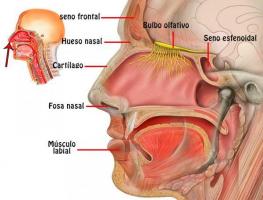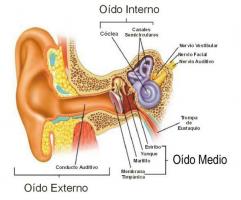CLASSIFICATION of ANIMALS according to their FEEDING
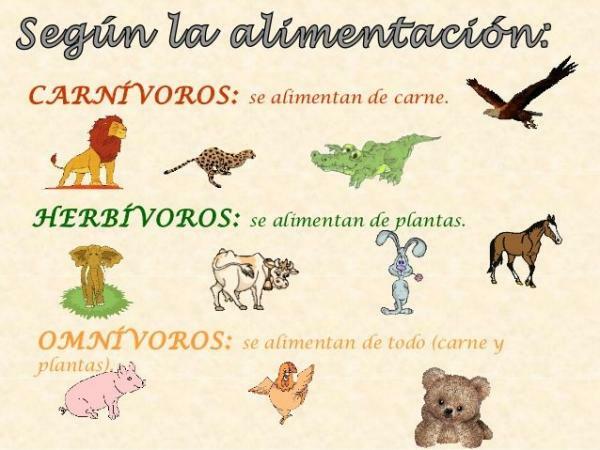
Image: Pinterest
In order to live and grow, animals have to feed ourselves. Through feeding and subsequent digestion, animals take the nutrients from food: carbohydrates, fats, proteins, fiber, minerals, vitamins and water. Animals can be classified according to their main food source and, as we will see later, this will be of great importance. in the role that he plays in the ecosystem where he lives, the habits he has or what his body is like (for example, his teeth or his stomach). In this lesson from a TEACHER we will see the classification of animals according to their diet and we will also study the most common types of animal feed. If you want to know more about animal feeding, keep reading!
Index
- The importance of feeding in animals
- Herbivorous animals
- Carnivorous animals
- Omnivorous animals
- What kind of food do we humans have?
The importance of feeding in animals.
Before starting to talk about the classification of animals according to their diet, it is important to understand the importance of nutrition in animal life. Food is a very important part of the life of animals. Food, unlike nutrition, is
a conscious process by which the animal chooses the food that he is going to consume, in some cases he even prepares it (removes dirt, peel, seeds, etc.) and puts it in his mouth and chews it. Instead, nutrition is an unconscious process by which the food consumed is digested and the body extracts the nutrients through chemical and biochemical reactions.In addition to being a conscious process, feeding is a great determinant of the animals' lives. As we will see below, on many occasions the body and customs of the animals have to be adapted to their way of eating. For example, fruit-eating monkeys are adapted to climbing trees, jumping, and being very agile to be able to pick up fruits while Cows, which feed on grass, do not need to climb but do need very sharp teeth to break up the grass as much as possible before it reaches their stomach.
Other animals are hunters, and they have to develop more or less complicated strategies to get hold of their prey; On the other hand, others feed on carrion, dead animals that are mostly remains left by hunting animals, so they have to have strategies to separate the hunter from his prey, avoid them or in some cases even flee if the hunter returns and things get ugly. The type of diet, their customs and their habits determine the place of the food chain where the animal is (who eats it and who eats it) and its role in the ecosystem.
Animals can be classified according to their feeding habits in: herbivores, carnivoresY omnivores, although this classification is not followed for human beings who, as we will see below, have a great variety of routines and eating habits.
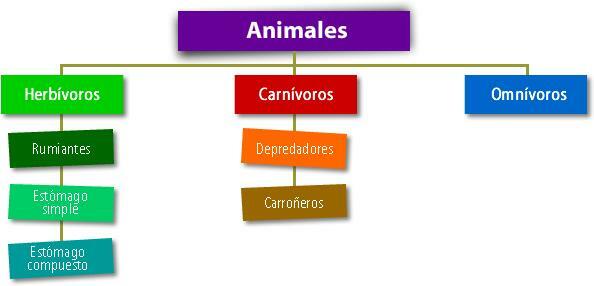
Image: Educational Portal
Herbivorous animals.
As we have already commented, within the classification of animals according to their diet we find the herbivores that feed almost exclusively on plants, although they can sometimes eat animal eggs, insects, milk, etc. Herbivores feed mainly on leaves (folivorous herbivores) or fruits (frugivorous herbivores) but they can also consume seeds, roots or even wood (xylophagous herbivores). Within the food chain, herbivores are the first link that follows plants, which is why they are called primary consumers.
In nature, probably the most important herbivores due to their number are the insects, which feed on a wide variety of plant tissues: termites feed on its wood, aphids on its sage and caterpillars on its leaves. Caterpillars can eat tons of tree leaves and even deforest entire forests!
Within the mammalsThere are also a large number of herbivorous animals, but the most popular and probably the most important group is that of the ruminants. There are 250 species of ruminants distributed throughout the world, except Australia and the best known are deer, sheep, goats, cows and giraffes. They differ by having four cavities in the stomach and a very peculiar way of feeding: they eat a large amount of food in one go, semi-crushed, which passes to the belly and then to the mesh (the first two cavities of the stomach).
Later, little by little, the ruminant passes small portions of this bolus to the mouth and chews it calmly with its molars until the food is completely crushed. This process is called rumination. Once ruminated, the small portion of food passes to the last two parts of the stomach: first to the book and then to curdling. Mammalian herbivores are also classified according to the type of stomach they have: simple stomach (rabbits) or compound stomach (goat).
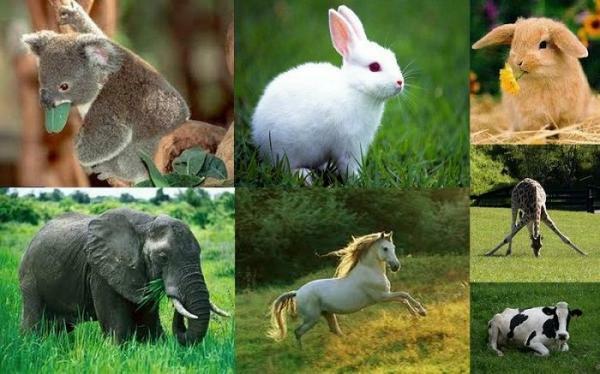
Image: Animals
Carnivorous animals.
Animals carnivores or zoophages are characterized by eating only or mainly meat to feed themselves since some carnivores can also eat some fruits or even honey. The former are called strict carnivores and their diet consists of more than 70% meat. Carnivores can feed on live animals, which they have to hunt (predators) or dead animals, either due to natural causes or because predators have hunted them (scavengers). Furthermore, predators can be classified according to the type of animal they feed on.
Thus, for example, animals that eat insects are insectivores while those that eat ants and termites are myrmecophagi. The best known predators are the lions and coyotes but birds (such as the kingfisher) or even some species of flies are also very powerful predators; the best known scavengers are hyenas, raccoons and vultures, but the most numerous are flies, beetles, ants and wasps.
Carnivorous animals occupy the highest positions in the food chain and normally the strict carnivores are at their peak. Carnivores are usually secondary or tertiary consumers and their role within ecosystems is very important since regulate populations of primary consumers.
In return, when carnivore populations get out of control, primary consumer populations do too: a very drastic reduction of predators means that there are a large number of primary consumers, which will destroy the plants in the ecosystem; a large number of predators greatly reduces the population of primary consumers, and plants will take over the power of the ecosystem.
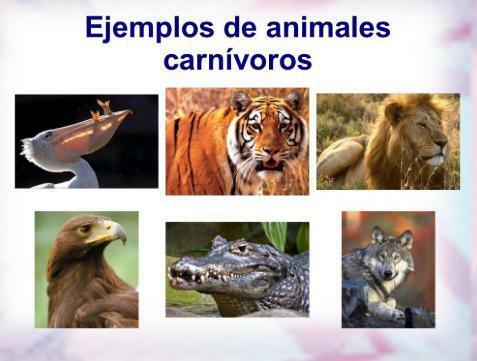
Omnivorous animals.
Finally, within the classification of animals according to their diet we find the omnivores what are those who feed tboth meat and plants.
Some animals base their diet more on vegetables, while still having a large consumption of foods of animal origin, while others eat equally animal foods and vegetables. These animals are commonly said to be quite generalists and opportunists, since they are not very adapted to eating a certain type of food and are available to what the environment offers them in every occasion (they have teeth of different sizes and shapes, stomachs and intestines that digest both vegetables and meat, etc.)
This is not bad as it allows them adapt to very changing environments or to situations where one of the food sources is in short supply. Because of this, when omnivorous animals reproduce too much and become a pest in an ecosystem, it is very difficult to eliminate them by cutting off their power source, as they can subsist on food alternative.
Some examples of mammalian omnivorous animals are bears, pigs, foxes, rats and mice, hedgehogs and skunks although there are also a large number of omnivorous birds such as crows, chickens or seagulls and other animals such as piranhas or turtles.

What kind of food do we humans have?
Humans, as a "late" species of the genus Homo, are omnivores. Archaeological evidence shows that, originally, human beings had a diet based on foods of animal and vegetable origin, since our diet was typical of a society hunter-gatherer.
Throughout history, humans have been able to develop great technological advances in crop and livestock yield, food processing, etc. what has made it capable of increasing the performance, duration and quality of natural foods.
Currently, for reasons religious, cultural, social, ideological, etc.Some people decide to base their diet on a certain group of foods, leaving out others or even eliminating them altogether. Some examples are the Mediterranean diet, vegetarianism (with numerous variants), veganism, the Paleolithic diet, etc. Remember, people who eat exclusively or primarily plant-based are not herbivores, they are vegetarians or vegans.
At other times, for Medical reasonsSome people have to eliminate certain foods from their diet, for example in celiac disease, in which patients must completely avoid consuming gluten; In other people, allergies or other milk proteins or sugars present in the fruit may appear, which they should avoid as much as possible. Finally, in certain cases there is hypersensitivity to certain substances such as lactose, certain fats or sugars, so people decide to reduce their consumption to avoid discomfort.
Whether it is for ideological, religious, social or medical reasons, you decide to follow one of these diets, remember that to eat a healthy diet that provides you with all the necessary nutrients you should consult a doctor and / or nutritionist.
If you want to read more articles similar to Classification of animals according to their diet, we recommend that you enter our category of biology.

